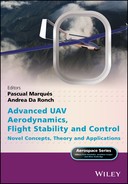Preface
Advanced UAV Aerodynamics, Flight Stability and Control: Novel Concepts, Theory and Applications has been written for university students and lecturers, aerodynamics researchers, aerospace engineers, and aircraft designers and manufacturers. Readers will need to have foundational knowledge of aerodynamics and principles of flight stability and control. Nonetheless, Chapter 1 provides an introduction to Aerodynamics and Flight Stability for the benefit of readers who do not have a conventional engineering background. The technical level of the book is ‘advanced’, and includes many equations and data. However, descriptive narratives are also used to elucidate concepts in language that is not excessively technical. Each Chapter is illustrated using diagrams and/or photos in colour.
The book is divided into two parts. Part I addresses novel concepts in unmanned aircraft aerodynamics and contains chapters on fixed‐wing (airplanes), rotary wing (helicopter), and hybrid aircraft. Part II presents novel concepts in unmanned aircraft flight stability and control and includes chapters on fixed‐wing (airplanes) and quad‐rotor aircraft. The reader will find in this textbook very sophisticated design concepts for unmanned aerospace vehicles and analyses of the aerodynamic environment, including aerodynamics of re‐entry vehicles, aeroservoelastic analysis of very flexible aircraft, wind tunnel testing, ground‐effect aerodynamics, dynamics modelling and system identification of helicopters, radial basis function neural networks, optimization of rotor blades with approximate BERP tips, helicopter trailing‐edge flaps, blade twist using smart actuation, aerodynamics of hover‐to‐dash convertible UAVs, closed‐loop flow control, autonomous gust alleviation, virtual flight simulation using Cfd, flow‐structure modification using plasma actuation, constrained motion planning and trajectory optimization, autonomous space navigation, adaptive fault‐tolerant attitude control of spacecraft, multi‐rotor Vtol Uav dynamics and stability, and system identification and flight control of quadrotors.
Advanced UAV Aerodynamics, Flight Stability and Control: Novel Concepts, Theory and Applications is the first book dedicated to unveiling the secrets of the rapidly developing field of unmanned aircraft aeronautics. Aeronautics is a wide‐ranging and multi‐disciplinary specialism covering several disciplines and domains of engineering that together enable the aerospace industry to produce unique, technologically advanced unmanned aircraft. This book makes the wealth of knowledge and experience of world‐class researchers and industry experts available to aerospace practitioners and university students.
Aerodynamics is the underlying science that underpins aircraft flight. Much of the efficiency of modern unmanned aircraft is due to the ability of engineers to model aerodynamic flows using sophisticated computational fluid dynamics. This book promotes an understanding of the underlying physical laws and the mathematical treatment of the topic, as well as more advanced theory and innovations in flight stability and control engineering.
Technological innovation and increasingly diverse applications are two key drivers of the rapid expansion of unmanned aircraft technology. The global defence budget for unmanned aircraft procurement is expanding, and the market for civilian unmanned aircraft is expected to surpass it. The book presents the state of the art of unmanned aircraft aerodynamic models of different configurations, real‐world flight stability, and control strategy validation in experimental platforms. This advanced level treatment of the aerodynamics of both fixed‐wing and rotary‐wing flight will appeal to aircraft design engineers and undergraduate and graduate students of aeronautics, as well as practising engineers looking for a refresher textbook on the subject.
Key Features
- Modern treatment and real‐world research on aerodynamics and flight stability.
- Presentation of important contemporary trends in flight control systems.
- Detailed and rigorous exposition and examples, with illustrations.
- Ancillary PowerPoint presentations for lecturers available on an accompanying website.
We are enormously grateful to the authors, who are world class experts in the field, for dedicating part of their precious time to contribute to the book. In chapter order, contributions are provided by Dr. Giuseppe Pezzella, Prof. Antonio Viviani, Nikolaos N. Tantaroudas, Dr. Andrea Da Ronch, Dr. Rafael Bardera Mora, Dr. Qiulin Qu, Prof. Ramesh K. Agarwal, Prof. Wen‐Hua Chen, Dr. Cunjia Liu, Prof. Ranjan Ganguli, Dr. Catherine S. Johnson, Dr. Mark Woodgate, Prof. George N. Barakos, Dr. Pascual Marqués, Dr. Ron Barrett‐Gonzalez, Dr. Oksana Stalnov, Prof. Daniel J. Inman, Dr Ya Wang, Ubaidullah Akram, Marco Cristofaro, Dr. Antonio Jesús Conesa Torres, Prof. Seid H Pourtakdoust, Dr. Jalal Karimi, Dr. Maryam Kiani, Prof. Qinglei Hu, Dr. Bing Xiao, Dr. Bo Li, Dr Youmin Zhang, Dr. Emaid A. Abdul Retha, Wei Wei, Dr. Mark B. Tischler, Nicholas J. Schwartz, and Prof. Kelly Cohen.
